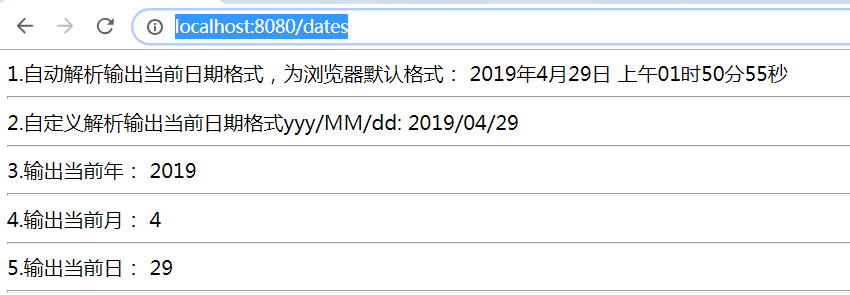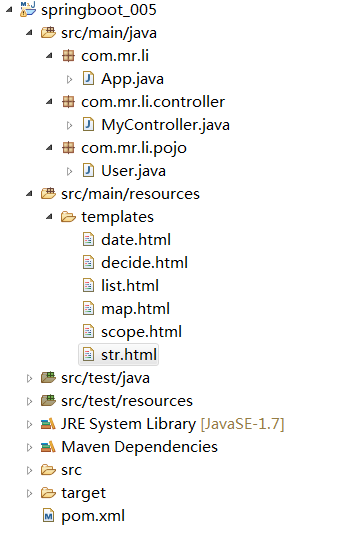Thymeleaf中有自己的表达式,和自己的语法,可以把数据取出来后再进行判断,遍历等操作,另外它还封装了strings,dates....对象,可以利用这些对象对已有的数据进行简单的逻辑处理;
1.pom.xml
<project xmlns="http://maven.apache.org/POM/4.0.0" xmlns:xsi="http://www.w3.org/2001/XMLSchema-instance" xsi:schemaLocation="http://maven.apache.org/POM/4.0.0 http://maven.apache.org/xsd/maven-4.0.0.xsd"> <modelVersion>4.0.0</modelVersion> <parent> <groupId>org.springframework.boot</groupId> <artifactId>spring-boot-starter-parent</artifactId> <version>1.5.10.RELEASE</version> </parent> <groupId>com.mr.li</groupId> <artifactId>springboot_005</artifactId> <version>0.0.1-SNAPSHOT</version> <!-- 修改jdk版本 --> <properties> <java.version>1.7</java.version> <!-- 将thymeleaf的版本升级一下,好处是:不会限制自动生成的html中编码标签结束没有结束符的错误 --> <thymeleaf.version>3.0.2.RELEASE</thymeleaf.version> <thymeleaf-layout-dialect.version>2.0.4</thymeleaf-layout-dialect.version> </properties> <dependencies> <!-- springBoot引入web启动器 --> <dependency> <groupId>org.springframework.boot</groupId> <artifactId>spring-boot-starter-web</artifactId> </dependency> <!-- springBoot引入thymeleaf视图模板启动器 --> <dependency> <groupId>org.springframework.boot</groupId> <artifactId>spring-boot-starter-thymeleaf</artifactId> </dependency> </dependencies> </project>
2.启动类
package com.mr.li; import org.springframework.boot.SpringApplication; import org.springframework.boot.autoconfigure.SpringBootApplication; @SpringBootApplication public class App { public static void main(String[] args) { SpringApplication.run(App.class, args); } }
3.MyController:各个方法的演示,方法的返回值都是对应的html名称
package com.mr.li.controller; import java.util.ArrayList; import java.util.Date; import java.util.HashMap; import java.util.List; import java.util.Map; import javax.servlet.ServletContext; import javax.servlet.http.HttpServletRequest; import javax.servlet.http.HttpSession; import org.springframework.stereotype.Controller; import org.springframework.ui.Model; import org.springframework.web.bind.annotation.RequestMapping; import com.mr.li.pojo.User; @Controller public class MyController { /** * 使用thymeleaf获取字符串:str是html的名字。 * 将字符串添加到model属性中,而model对象是springboot封装过的,在这里用于HTML中获取。 * @param model * @return */ @RequestMapping("/strs") public String show1(Model model) { model.addAttribute("str", "heLLLlo world"); return "str"; } /** * 演示:在html中遍历取出list中的内容 * @param model * @return */ @RequestMapping("/lists") public String show2(Model model) { List<User> list = new ArrayList<User>(); list.add(new User(1, "小明", 15)); list.add(new User(2, "小刚", 16)); list.add(new User(3, "小丽", 14)); model.addAttribute("list", list); return "list"; } /** * 演示map:在html中取出map操作 * @param model * @return */ @RequestMapping("/maps") public String show3(Model model) { Map<String, User> map = new HashMap<String, User>(); map.put("user1", new User(1, "张三", 15)); map.put("user2", new User(2, "李四", 16)); map.put("user3", new User(3, "王五", 17)); model.addAttribute("map", map); return "map"; } /** * 演示使用thymeleaf在html中操作date类型 * @param model * @return */ @RequestMapping("/dates") public String show4(Model model) { model.addAttribute("date", new Date()); return "date"; } /** * 演示作用域:在html中使用作用域 * @param request * @param model * @return */ @RequestMapping("/scopes") public String show5(HttpServletRequest request, Model model) { request.setAttribute("req", "my is request!!!"); HttpSession session = request.getSession(); session.setAttribute("session" , "my is httpsession"); ServletContext context = request.getSession().getServletContext(); context.setAttribute("application", "my is application!!!"); return "scope"; } /** * 演示在html判断数据 * @param model * @return */ @RequestMapping("/decides") public String show6(Model model) { model.addAttribute("id", 2); model.addAttribute("sex", "男"); return "decide"; } }
4.实体类,便于生成数据源,方便演示
package com.mr.li.pojo; public class User { private int id; private String name; private int age; public int getId() { return id; } public void setId(int id) { this.id = id; } public String getName() { return name; } public void setName(String name) { this.name = name; } public int getAge() { return age; } public void setAge(int age) { this.age = age; } public User() { // TODO Auto-generated constructor stub } public User(int id, String name, int age) { super(); this.id = id; this.name = name; this.age = age; } }
5.date.html 演示日期操作
<!DOCTYPE html> <html> <head> <meta charset="UTF-8"/> <title>使用Thymeleaf演示Date类型</title> </head> <body> <!-- date值是controller中model对象的属性key名称 --> 1.自动解析输出当前日期格式,为浏览器默认格式: <span th:text="${#dates.format(date)}"></span> <hr/> 2.自定义解析输出当前日期格式yyy/MM/dd: <span th:text="${#dates.format(date, 'yyy/MM/dd')}"></span> <hr/> 3.输出当前年: <span th:text="${#dates.year(date)}"></span> <hr/> 4.输出当前月: <span th:text="${#dates.month(date)}"></span> <hr/> 5.输出当前日: <span th:text="${#dates.day(date)}"></span> <hr/> </body> </html>
访问url: http://localhost:8080/dates

6.decide.html 用Thymeleaf演示判断
<!DOCTYPE html> <html> <head> <meta charset="UTF-8"> <title>使用Thymeleaf演示if、switch判断操作</title> </head> <body> <span th:if = "${sex} == '男'"> 此人性别:男 </span> <span th:if = "${sex} == '女'"> 此人性别:女 </span> <div th:switch="${id}"> <span th:case="1">此人id为:1</span> <span th:case="2">此人id为:2</span> <span th:case="3">此人id为:3</span> </div> </body> </html>
url: http://localhost:8080/decides

7.list.html list处理数据演示
<!DOCTYPE html> <html> <head> <meta charset="UTF-8"/> <title>使用Thymeleaf演示List类型</title> </head> <body> <table border="1"> <tr> <th>ID</th> <th>名称</th> <th>年龄</th> <th>索引</th> <th>计数</th> <th>集合大小</th> <th>计数是否为偶数</th> <th>计数是否为奇数</th> <th>当前是否为集合中的第一个元素</th> <th>当前是否为集合中最后一个元素</th> </tr> <!-- u:是当前遍历的对象,var:是Thymeleaf帮我们封装的当前对象 --> <tr th:each="u,var : ${list}"> <td th:text="${u.id}"></td> <td th:text="${u.name}"></td> <td th:text="${u.age}"></td> <td th:text="${var.index}"></td> <td th:text="${var.count}"></td> <td th:text="${var.size}"></td> <td th:text="${var.even}"></td> <td th:text="${var.odd}"></td> <td th:text="${var.first}"></td> <td th:text="${var.last}"></td> </tr> </table> </body> </html>
url : http://localhost:8080/lists

8.map.html map处理数据演示
<!DOCTYPE html> <html> <head> <meta charset="UTF-8"/> <title>使用Thymeleaf演示Map类型</title> </head> <body> <table border="1"> <tr> <th>ID</th> <th>名称</th> <th>年龄</th> </tr> <!--遍历map方式一 --> <!-- <tr th:each="maps : ${map}"> <td th:each="user : ${maps}" th:text="${user.value.id}"></td> <td th:each="user : ${maps}" th:text="${user.value.name}"></td> <td th:each="user : ${maps}" th:text="${user.value.age}"></td> </tr> --> <!-- 遍历map方式二:拿出map然后循环会拿出他的对象,输出每个对象,value为关键字 --> <tr th:each="user : ${map}"> <td th:text="${user.value.id}"></td> <td th:text="${user.value.name}"></td> <td th:text="${user.value.age}"></td> </tr> </table> </body> </html>
url: http://localhost:8080/maps

9.str.html string类型处理数据演示
<!DOCTYPE html> <html> <head> <meta charset="UTF-8"/> <title>使用Thymeleaf演示String类型</title> </head> <body> 演示输出: <span th:text=" ${str}"></span> <hr/> 1.检查此字符串是否为空: <span th:text="${#strings.isEmpty(str)}"></span> <hr/> 2.检查此str字符串送是否包含“h”: <span th:text="${#strings.contains(str,'h')}"></span> <hr/> 3.检查str中的第一个字符是否为“b”: <span th:text="${#strings.startsWith(str,'b')}"></span> <hr/> 4.检查str中最后一个字符是否为“s”: <span th:text="${#strings.endsWith(str,'s')}"></span> <hr/> 5.输出str的长度: <span th:text="${#strings.length(str)}"></span> <hr/> 6.截取str中某段字符的内容,包头不包尾,若只有一个值则从此值往后直到结束: <span th:text="${#strings.substring(str,3,5)}"></span> <hr/> 7.输出此字符“o”的索引值: <span th:text="${#strings.indexOf(str,'o')}"></span> <hr/> 8.将str所有字符转为大写: <span th:text="${#strings.toUpperCase(str)}"></span> <hr/> 9.将str所有字符转为小写: <span th:text="${#strings.toLowerCase(str)}"></span> <hr/> </body> </html>
url: http://localhost:8080/strs

10.scope.html 作用域演示
<!DOCTYPE html> <html> <head> <meta charset="UTF-8"/> <title>使用Thymeleaf演示Request、HttpSession、Application(ServletContext)作用域类型</title> </head> <body> <!-- httpServletRequest对象是Thymeleaf提供的,方法也是,都不能错,req是controller中赋值时的key --> Request作用域的值获取,赋值在controller中:<span th:text="${#httpServletRequest.getAttribute('req')}"></span> <hr/> <!-- 第一个session是Thymeleaf提供的,第二个session是controller中赋值的key --> Session作用域获取值,赋值在controller中:<span th:text="${session.session}"></span> <hr/> <!-- 第一个application是Thymeleaf提供的,第二个application是controller中赋值的key --> Application作用域获取值,赋值在controller中:<span th:text="${application.application}"></span> </body> </html>
url: http://localhost:8080/scopes

项目结构:

关于url:
<!DOCTYPE html> <html> <head> <meta charset="UTF-8"> <title>Thymeleaf-URL</title> </head> <body> <a th:href="@{http://www.baidu.com}">绝对路径</a><br/> <a href="http://www.baidu.com">绝对路径2</a> <hr/> <!-- 此时回去找名为show的这个controller --> <a th:href="@{/show}">相对路径</a> <hr/> <a th:href="@{~/project2/resourcename}">相对于服务器的根</a> <hr/> <a th:href="@{/show(id=1,name=zhagnsan)}">相对路径-传参</a> <hr/> <a th:href="@{/path/{id}/show(id=1,name=zhagnsan)}">相对路径-传参-restful</a> </body> </html>
以上就是thymeleaf的简单应用